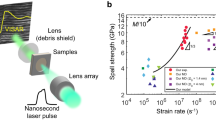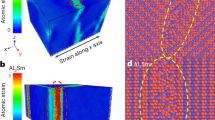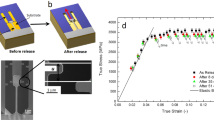Abstract
Hard and brittle materials usually exhibit a much lower strength when loaded in tension than in compression. However, this common-sense behaviour may not be intrinsic to these materials, but arises from their higher flaw sensitivity to tensile loading. Here, we demonstrate a reversed and unusually pronounced tension–compression asymmetry (tensile strength exceeds compressive strength by a large margin) in submicrometre-sized samples of isotropic amorphous silicon. The abnormal asymmetry in the yield strength and anelasticity originates from the reduction in shear modulus and the densification of the shear-activated configuration under compression, altering the magnitude of the activation energy barrier for elementary shear events in amorphous Si. In situ coupled electrical tests corroborate that compressive strains indeed cause increased atomic coordination (metallization) by transforming some local structures from sp3-bonded semiconducting motifs to more metallic-like sites, lending credence to the mechanism we propose. This finding opens up an unexplored regime of intrinsic tension–compression asymmetry in materials.
This is a preview of subscription content, access via your institution
Access options
Access Nature and 54 other Nature Portfolio journals
Get Nature+, our best-value online-access subscription
$29.99 / 30 days
cancel any time
Subscribe to this journal
Receive 12 print issues and online access
$259.00 per year
only $21.58 per issue
Buy this article
- Purchase on Springer Link
- Instant access to full article PDF
Prices may be subject to local taxes which are calculated during checkout




Similar content being viewed by others
Data availability
Source data are provided with this paper. Additional data reported in the Supplementary Information are available from the corresponding authors upon request.
Code availability
The computer codes are available from the corresponding authors upon reasonable request.
References
Meyers, M. A. & Chawla, K. K. Mechanical Behavior of Materials 2nd edn (Cambridge Univ. Press, 2008).
Chen, X., Wu, S. & Zhou, J. Influence of porosity on compressive and tensile strength of cement mortar. Constr. Build. Mater. 40, 869–874 (2013).
Pelleg, J. Mechanical Properties of Ceramics Vol. 213 (Springer Science and Business, 2014).
Wachtman, J. B., Cannon, W. R. & Matthewson, M. J. Mechanical Properties of Ceramics (John Wiley and Sons, 2009).
Davidge, R. Mechanical properties of ceramic materials. Contemp. Phys. 10, 105–124 (1969).
Griffith, A. The phenomena of flow and rupture in solids. Phil. Trans. R. Soc. A 221, 163–198 (1920).
Zhao, P., Li, J. & Wang, Y. Extended defects, ideal strength and actual strengths of finite-sized metallic glasses. Acta Mater. 73, 149–166 (2014).
Zhang, H. et al. Approaching the ideal elastic strain limit in silicon nanowires. Sci. Adv. 2, e1501382 (2016).
Banerjee, A. et al. Ultralarge elastic deformation of nanoscale diamond. Science 360, 300–302 (2018).
Tian, L. C. et al. Approaching the ideal elastic limit of metallic glasses. Nat. Commun. 3, 609 (2012).
Hedler, A., Klaumünzer, S. L. & Wesch, W. Amorphous silicon exhibits a glass transition. Nat. Mater. 3, 804–809 (2004).
Treacy, M. & Borisenko, K. B. The local structure of amorphous silicon. Science 335, 950–953 (2012).
Wang, Y. et al. Tunable anelasticity in amorphous Si nanowires. Nano Lett. 20, 449–455 (2020).
Sriraman, S., Agarwal, S., Aydil, E. S. & Maroudas, D. Mechanism of hydrogen-induced crystallization of amorphous silicon. Nature 418, 62–65 (2002).
Deringer, V. L. B. et al. Origins of structural and electronic transitions in disordered silicon. Nature 589, 59–64 (2021).
Gerbig, Y. B., Michaels, C. A., Bradby, J. E., Haberl, B. & Cook, R. F. In situ spectroscopic study of the plastic deformation of amorphous silicon under nonhydrostatic conditions induced by indentation. Phys. Rev. B 92, 214110 (2015).
Liu, K., Ostadhassan, M., Bubach, B., Dietrich, R. & Rasouli, V. Nano-dynamic mechanical analysis (nano-DMA) of creep behavior of shales: Bakken case study. J. Mater. Sci. 53, 4417–4432 (2018).
Ye, J. C., Lu, J., Liu, C. T., Wang, Q. & Yang, Y. Atomistic free-volume zones and inelastic deformation of metallic glasses. Nat. Mater. 9, 619–623 (2010).
Herbert, E., Oliver, W. C. & Pharr, G. M. Nanoindentation and the dynamic characterization of viscoelastic solids. J. Phys. D Appl. Phys. 41, 074021 (2008).
Yuan, Y. & Verma, R. Measuring microelastic properties of stratum comeum. Colloids Surf. B 48, 6–12 (2006).
Stillinger, F. H. & Weber, T. A. Computer simulation of local order in condensed phases of silicon. Phys. Rev. B 31, 5262–5271 (1985).
Justo, J. F., Bazant, M. Z., Kaxiras, E., Bulatov, V. V. & Yip, S. Interatomic potential for silicon defects and disordered phases. Phys. Rev. B 58, 2539–2550 (1998).
Bartok, A. P., Kermode, J. R., Bernstein, N. & Csanyi, G. Machine learning a general-purpose interatomic potential for silicon. Phys. Rev. X 8, 041048 (2018).
Deringer, V. L. et al. Realistic atomistic structure of amorphous silicon from machine-learning-driven molecular dynamics. J. Phys. Chem. Lett. 9, 2879–2885 (2018).
Johnson, W. & Samwer, K. A universal criterion for plastic yielding of metallic glasses with a (T/Tg)2/3 temperature dependence. Phys. Rev. Lett. 95, 195501 (2005).
Fan, Z. & Ma, E. Predicting orientation-dependent plastic susceptibility from static structure in amorphous solids via deep learning. Nat. Commun. 12, 1506 (2021).
Demkowicz, M. J. & Argon, A. S. High-density liquidlike component facilitates plastic flow in a model amorphous silicon system. Phys. Rev. Lett. 93, 025505 (2004).
Rubinstein, M. & Panyukov, M. Nonaffine deformation and elasticity of polymer networks. Macromolecules 30, 8036–8044 (1997).
Argon, A. & Demkowicz, M. What can plasticity of amorphous silicon tell us about plasticity of metallic glasses? Metall. Mater. Trans. A 39, 1762–1778 (2008).
Demkowicz, M. J. & Argon, A. S. Liquidlike atomic environments act as plasticity carriers in amorphous silicon. Phys. Rev. B 72, 245205 (2005).
Fan, Z., Ding, J., Li, Q. J. & Ma, E. Correlating the properties of amorphous silicon with its flexibility volume. Phys. Rev. B 95, 144211 (2017).
Boioli, F., Albaret, T. & Rodney, D. Shear transformation distribution and activation in glasses at the atomic scale. Phys. Rev. E 95, 033005 (2017).
Morishita, T. High density amorphous form and polyamorphic transformations of silicon. Phys. Rev. Lett. 93, 055503 (2004).
Cheng, Y. & Ma, E. Atomic-level structure and structure–property relationship in metallic glasses. Prog. Mater. Sci. 56, 379–473 (2011).
Schuh, C. A. & Lund, A. C. Atomistic basis for the plastic yield criterion of metallic glass. Nat. Mater. 2, 449–452 (2003).
Li, W. et al. Deformation-driven diffusion and plastic flow in amorphous granular pillars. Phys. Rev. E 91, 062212 (2015).
Daisenberger, D., McMillan, P. F. & Wilson, M. Crystal-liquid interfaces and phase relations in stable and metastable silicon at positive and negative pressure. Phys. Rev. B 82, 214101 (2010).
Jiang, C. & Srinivasan, S. G. Unexpected strain-stiffening in crystalline solids. Nature 496, 339–342 (2013).
Johlin, E. et al. Structural origins of intrinsic stress in amorphous silicon thin films. Phys. Rev. B 85, 075202 (2012).
Gaire, C., Ye, D. X., Lu, T. M., Wang, G. C. & Picu, R. C. Deformation of amorphous silicon nanostructures subjected to monotonic and cyclic loading. J. Mater. Res. 23, 328–335 (2008).
Abadias, G. et al. Review article: stress in thin films and coatings: current status, challenges, and prospects. J. Vac. Sci. Technol. A 36, 020801 (2018).
Zhao, K. J., Li, Y. G. & Brassart, L. Pressure-sensitive plasticity of lithiated silicon in Li-ion batteries. Acta Mech. Sin. 29, 379–387 (2013).
Plimpton, S. Fast parallel algorithms for short-range molecular dynamics. J. Comput. Phys. 117, 1–19 (1995).
Ding, J. et al. Universal structural parameter to quantitatively predict metallic glass properties. Nat. Commun. 7, 13733 (2016).
Acknowledgements
Z.S. and Y.W. acknowledge support from National Natural Science Foundation of China (51902249 and 5203000210), the National Key Research and Development Program of China (no. 2017YFB0702001) and China Postdoctoral Science Foundation (2019M663696). J.D. acknowledges support from National Natural Science Foundation of China (12004294) and National Youth Talents Program. J.L. acknowledges support by the National Science Foundation (DMR-1923976). L.T. acknowledges the Alexander von Humboldt Foundation and the Start-Bridge-Finish Program from International Center for Advanced Studies of Energy Conversion (ICASEC) for financial support. Z.F. thanks A. Bartok-Partay for the help in using the ML-based interatomic potential, and acknowledges the computational resources of the Maryland Advanced Research Computing Center. We thank R. Ritchie and M. Asta for helpful discussions. We thank J. Zhu, S. Yan and D. Zhang at Xi’an Jiaotong University for their assistance in nano dynamic mechanical analysis tests. E.M. and J.D. thank Xi’an Jiaotong University for supporting their work at the Center for Alloy Innovation and Design (CAID).
Author information
Authors and Affiliations
Contributions
E.M., J.L. and Z.S. supervised the project. Y.W. and L.T. carried out the experimental investigations with assistance from M.L., H.L. and Y.Z.; J.D. and Z.F. led the modelling effort. E.M. and Y.W. wrote the paper with input from J.D., Z.F., J.L. and Z.S. All authors contributed to the discussions.
Corresponding authors
Ethics declarations
Competing interests
The authors declare no competing interests.
Additional information
Peer review information Nature Materials thanks Paul McMillan and the other, anonymous, reviewer(s) for their contribution to the peer review of this work.
Publisher’s note Springer Nature remains neutral with regard to jurisdictional claims in published maps and institutional affiliations.
Supplementary information
Supplementary Information
Supplementary Figures 1-19, Supplementary Notes 1-3, Supplementary Table 1, and additional references 1–17.
Source data
Source Data Fig. 1
Statistical Source Data
Source Data Fig. 2
Statistical Source Data
Source Data Fig. 3
Statistical Source Data
Source Data Fig. 4
Statistical Source Data
Rights and permissions
About this article
Cite this article
Wang, Y., Ding, J., Fan, Z. et al. Tension–compression asymmetry in amorphous silicon. Nat. Mater. 20, 1371–1377 (2021). https://doi.org/10.1038/s41563-021-01017-z
Received:
Accepted:
Published:
Issue Date:
DOI: https://doi.org/10.1038/s41563-021-01017-z
This article is cited by
-
Microscopic mechanisms of pressure-induced amorphous-amorphous transitions and crystallisation in silicon
Nature Communications (2024)
-
Tension–Compression Flow Asymmetry as a Function of Alloy Composition in the Al-Si System
Journal of Materials Engineering and Performance (2024)
-
Non-affine atomic rearrangement of glasses through stress-induced structural anisotropy
Nature Physics (2023)
-
Tailoring mechanical heterogeneity, nanoscale creep deformation and optical properties of nanostructured Zr-based metallic glass
Rare Metals (2023)
-
A top-down strategy for amorphization of hydroxyl compounds for electrocatalytic oxygen evolution
Nature Communications (2022)



